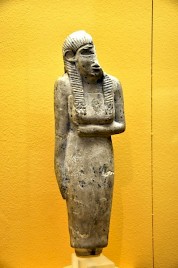Neithhotep
Queen Neithhotep lived during the final phase of Egypt’s Predynastic age and was presumably the wife of King Narmer, the unifier of the “Two Lands”, which may have taken place in the thirtieth century BCE.

Neithhotep is assumed to have been a princess from Lower Egypt who married the king of Upper Egypt in order to symbolically seal the unification. The assumption that she originated from Lower Egypt is based on her name (“Neith is satisfied”) which refers to the goddess Neith, a goddess who was viewed as patroness of Lower Egypt. According to the ancient Egyptians, she had created the world and given life to the sun god Ra. In addition, she was also the patroness of hunters and weavers and was associated with war. Her cult center was in Sais, in one of the oldest and most important of Egypt’s temples. The temple was built by King Hor-Aha, who may have been Neithhotep’s son.
The tomb of queen Neithhotep, or rather her mastaba, was discovered in Naqada (Upper Egypt) in 1897 by Jacques de Morgan and reveals her nobility. It is an unusually large building (approximately 23 x 56 meters) made of clay tiles. The niches in the exterior walls resemble those of a palace façade. The mastaba was immediately given the name “large tomb” and it was initially believed that the tomb of Narmer himself had been unearthed.
In the grave, cosmetics, stone bowls, ivory tags, and clay seal impressions were found bearing the names of Narmer, Hor-Aha, and Neithhotep. The queen’s name has also been found in a serekh. This is most exceptional because the serekh is believed to have been used only to indicate the titles of the (male) king. Neithhotep’s serekh, however, has been slightly modified: instead of a Horus falcon, the symbol of the goddess Neith (two curved arrows) has been applied.
Finally, her name was also found in the tombs of her son Hor-Aha and her grandson Djer (both at Abydos). In addition, her royal titles have also been handed down, namely: “consort of the two ladies” and “foremost of women”.
That is all evidence we have. It is believed that Neithhotep outlived her husband Narmer and temporarily presided over Egypt until her son Hor-Aha came of age. Another theory is that Neithhotep was married to Hor-Aha and became regent to their son Djer. This assumption is based on an interregnum, mentioned on the Stone of Palermo, between the rules of Hor-Aha and Djer. This interregnum lasted one year, one month and fifteen days and may indicate a short-lived regency.